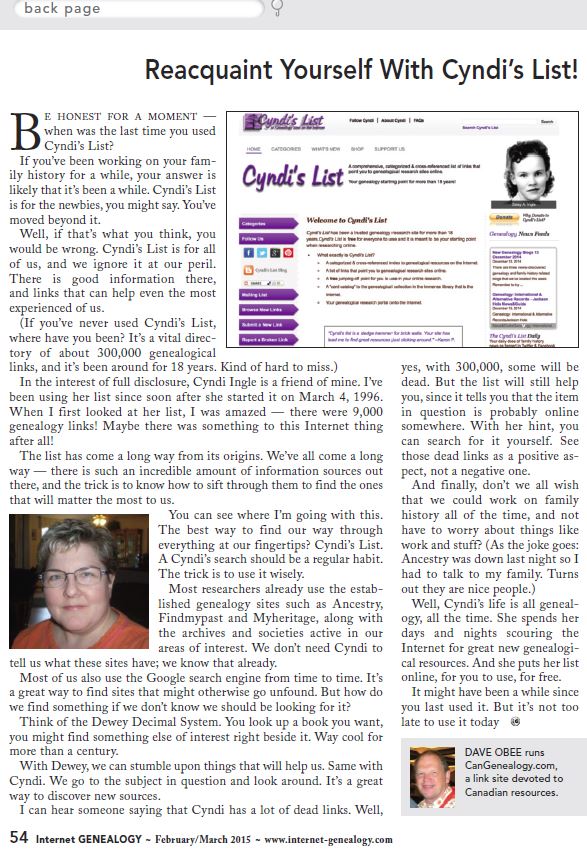** Understanding A Bit More About 18th Century Photography
** Reacquaint Yourself With Cyndi’s List
** Washington History Trivia: Bing Crosby’s Pipe
** Following Up: Digital Public Library & FamilySearch
The following is quoted from Edward Rutherfurd’s book, New York; I found his explanation of these facts so clear that I thought to share them with you:
1863, page 413: “His photographic studio was well equipped….. like the other photographers on the Bowery, his bread-and-butter business in recent years had been taking quick portraits of young men standing proudly, or sheepishly, in their unaccustomed uniforms, before they went off to fight again the South. Quicker than the old daguerreotype to take, easy to reproduce on paper, he’d get thirty customers a day sometimes. It paid the rent. At first, these small “carte-de-visite”-size portraits had seemed jolly enough, like taking someone’s picture at the seaside. Gradually, however, as the terrible casualties of the Civil War had mounted, he had realized that the dull little portraits he was taking were more like tombstones, last mementoes, before some poor fellow vanished from his family forever. And if he tried to make each humble one as splendid as he could, he did not tell his customers the reason.”
1871, page 488: The character was explaining why he didn’t get a photo of Lincoln speaking the Gettysburg Address…… Lincoln was so brief and: “It had been no easy business getting a picture in the Civil War. The photographs were always taken in 3-D, which meant that two plates had to be inserted simultaneously into a double camera, one to the left, one to the right. The glass plates had to be quickly cleaned, coated with collodion, then, while still wet, dipped in silver nitrate before being put into the camera. The exposure time might only be a few seconds, but then on had to rush the plates, still wet, into the mobile darkroom. Quite apart from the difficulties of having people in motion during the seconds of exposure, the whole process was so cumbersome that taking pictures of battlefield action was almost impossible. “
********************************
Have you renewed your subscription to CyndisList? Duh…. CyndisList is FREE and does not require a subscription, never has. This is author Dave Obee’s Back Page from the Feb-Mar 2015 issue of Internet Genealogy. This publication (IG) is a must-have-top-notch magazine and Dave’s “Back Page” comments are always right on. I agree with Dave; today is not too late to start using CyndisList. And without a subscription!

************************
Bing Crosby is a true Washington luminary and a very bright star in Spokane’s history. Not too long ago, Gonzaga University (Bing’s alma mater) had an exhibition of some of his things…….including a replica of his famous pipe.
“The bigger-than-life Bing Crosby bronze statue was dedicated in front of the Crosby Library (now the Crosby Student Center) on his birthday, May 3, 1981. Bing died on a golf course in Madrid, Spain, in October 1977. Sculpted by Debbie Copenhaver, the 8-foot bronze statue of Bing depicts him striking a pose with his pipe, hat, and golf clubs. Immediately after the statue’s installation, students unscrewed the pipe and took it away as a prank. Eventually, the pipe was returned. After numerous such pranks, the pipe was permanently removed and now is attached only for special occasions. This is one of three pipes.”
Darn kids anyway.
****************************
![]()
Few weeks back I posted about the DPLA, the Digital Public Library of America. Here’s a follow-up blurb:
“In concert with the American Library Association national conference this week, the Digital Public Library of America (DPLA) and FamilySearch International, the largest genealogy organization in the world, have signed an agreement that will expand access to FamilySearch.org’s growing free digital historical book collection to DPLA’s broad audience of users including genealogists, researchers, family historians, students and more.
Translation: All the book that FamilySearch has digitized (in the millions) will now additionally be available through DPLA…………… free, and fully viewable digitally. Dan Cohen, Executive Director for DPLA, sees the addition of FamilySearch’s digital book collection as part of DPLA’s ongoing mission to be an essential site for family history researchers. I couldn’t agree more! Have you checked out DPLA? Very simple website: www.dp.la